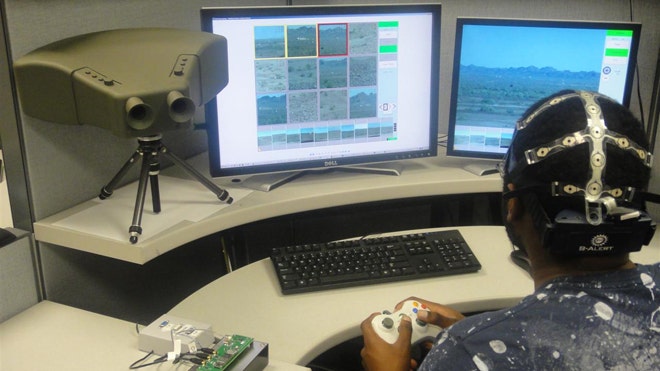 A brainwave-reading cap and a prototype binocular system
combine to monitor threats far more effectively than a human acting
alone.
A brainwave-reading cap and a prototype binocular system
combine to monitor threats far more effectively than a human acting
alone.By reading a soldier’s brain waves, new binoculars can detect a threat his brain has registered before he’s even conscious of it.
The Defense Advanced Research Projects Agency (DARPA) set out five years ago to provide the military with a far better device to visually detect threats. After all, the human eye’s limited field of view, breadth of area and the effects of fatigue can make relying on vision alone difficult.
They came up with the Cognitive Technology Threat Warning System program (CT2WS), binoculars paired that harness thoughts in the soldier’s brain.
It sounds like the stuff of science fiction, but CT2WS is based on real science: Humans are naturally skilled at detecting the out-of-the-ordinary -- and complex algorithms can interpret even subconscious human thoughts for computers to understand.
When the brain detects potentially threatening things like unexpected movements, it triggers a P-300 brain wave, a signal believed to connect with stimulus evaluation and categorization. The CT2WS system picks up those signals, translates them, and alerts the wearer of a threat through three key components.
The first is an electroencephalogram (EEG) cap that monitors the user’s brain signals. When the brain detects a threat, as seen through a tripod-mounted, 120-megapixel video camera with a 120-degree field of view, the cap records it. It's hardly the bird-watching binoculars you may be familiar with, but the system gets the job done.
The final part is complex visual processing algorithms that can run on a laptop, identifying potential targets and cuing images for the user to evaluate.
Testing revealed that while users were shown a rapid sequence of about ten images per second, their brains were still able to send signals flagging the relevant images, signals that could be read by the computer.
What about the classic rustle in the brush, however -- is it a bird or the enemy? The agency claims these cognitive algorithms have become so good that leaves rustling or wildlife movement that could be written off as typical nature will still be tagged as revealing potential threats.
Yet false alarm rates are greatly reduced through the EEG-based human filtering system.
Without a human and her brainwaves in the loop, the entire CT2WS system was tested and produced 810 false alarms per hour out of 2,304 events. But when a war fighter wears the EEG cap and contributes her brainpower to the system, false alarms were reduced to only 5 out of 2,304 events.
That’s a 91 percent improvement, thanks to those brain waves.
And target detection can reach 100 percent when commercial radar like Cerberus Scout is also deployed.
DARPA has been working with HRL Laboratories; Advanced Brain Monitoring; Quantum Applied Science & Research, Inc. and the University of California San Diego to create the system.
HRL Laboratories helped develop the sensor, cognitive and EEG decoding technologies. These sorts of advances are critical to harvesting an operator’s thought for the system.
Last year, the CT2WS was field-tested in a range of real environments including open desert at Arizona’s Yuma Proving Ground and tropical terrain in Hawaii, as well as open ground at California's Camp Roberts.
The results revealed the system can outperform trained humans, who detected about 60 percent of threats with binoculars. CT2WS wiped the floor with them, catching about 91 percent of risks.
Goals for this year included improving algorithms to increase frame rate and extending algorithms to handle imagery from Army and Marine Corps systems that generate visible, IR, and radar imagery from mast-mounted systems like Cerebus Scout.
Another critical aim for this year was to implement dry wearable EEG sensors that would not require conductive gels. DARPA awarded a contract to Quasar last September.
DARPA allocated $8.5 million last year and $1.75 million this year, providing a final demonstration to Army officials recently at Fort Belvoir, Va.
The CT2WS technology is currently being transitioned to the Night Vision and Electronic Sensors Directorate (NVEDS) in Fort Belvoir, where the first night vision goggles were created.
Since debuting those groundbreakers, NVEDS claimed to "own the night." Will they soon own the brain waves, too?
No comments:
Post a Comment